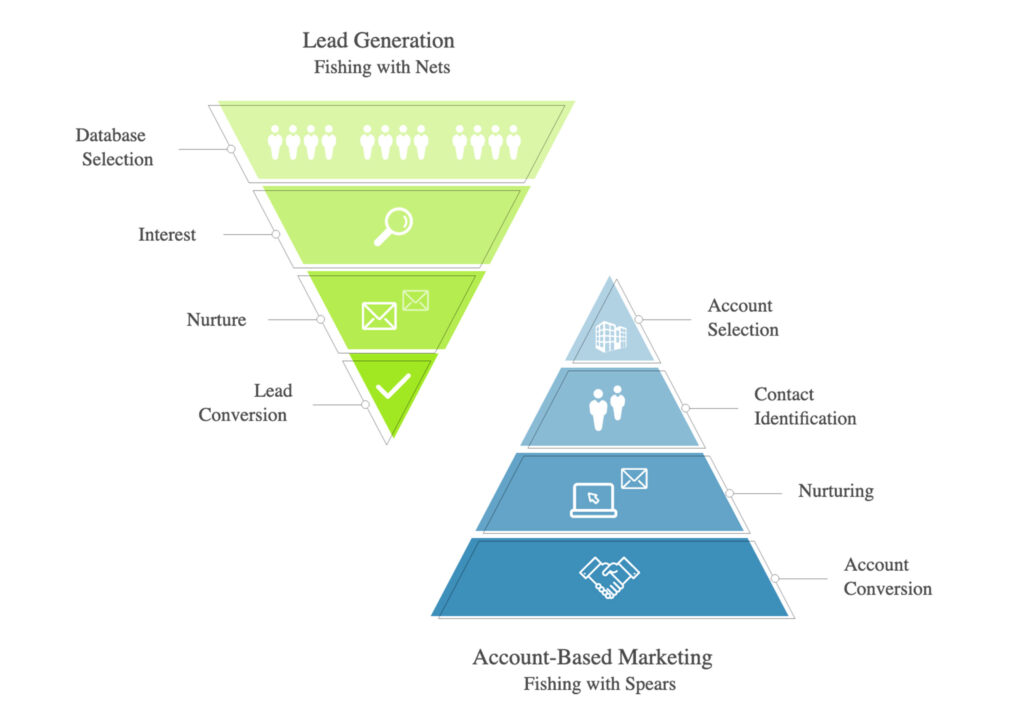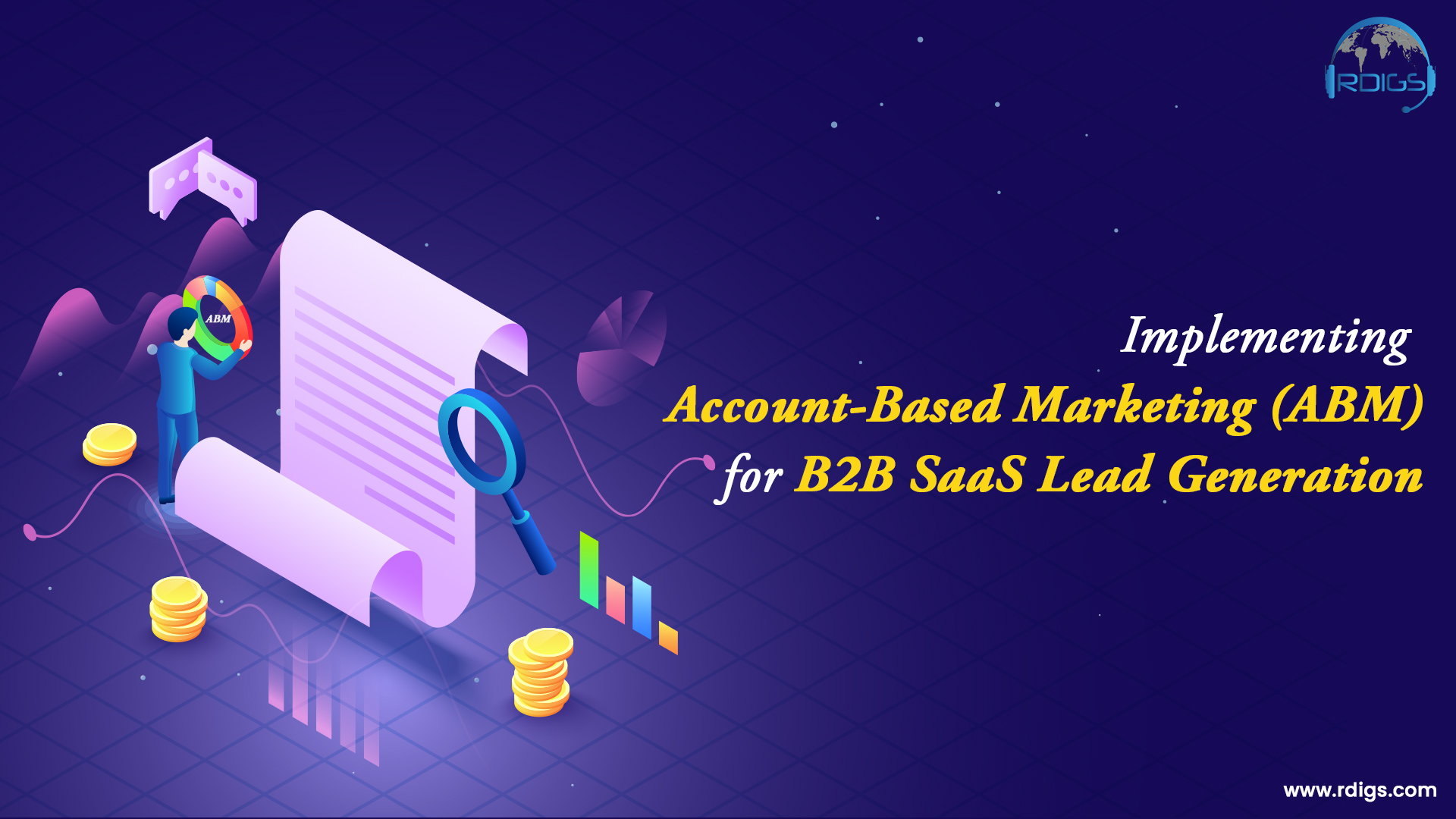Before we discuss Account-Based Marketing for B2B SaaS, let’s start with this:
There are millions of lead-generation strategies. Which ones do well? Which ones work for B2B SaaS companies?
It’s challenging to generate B2B SaaS leads. Exactly why?
Cold emails and untargeted marketing are no longer helpful for SaaS companies. Today, customers drive much of their journey. Your lead-generation strategies should be personalized.
Lead generation promotes B2B SaaS products. It’s about meeting clients where they are and showing how your software solves their biggest challenges.
Technology and data accessibility have made ABM tactics popular in B2B SaaS lead creation.
Imagine selling directly to your best-fit, highest-value accounts while saving time on qualified leads. Engage and delight target accounts immediately.
Account-based marketing lets you quickly eliminate less-valuable companies and unify Marketing and Sales. Your team can accelerate account engagement and delight.
ABM helps your organization communicate with high-value accounts like individual markets. Personalizing the buyer’s experience and targeting communications, content, and campaigns to particular accounts will increase ROI and customer loyalty.
What is account-based marketing?
Account-based marketing is a B2B marketing strategy that aligns sales and marketing efforts to deliver targeted advertising, personalized content, and messaging to high-value accounts.
ABM isn’t new, however. B2B marketers have used it for well over a decade. But rapid advances in the sophistication and accessibility of relevant data — and in technologies that enable ABM — are fueling widespread interest and adoption of this approach.
An account-based marketing strategy recognizes that a group often makes B2B purchase decisions of individuals within the company. ABM tools automate many of the data and workflow processes that enable this approach.
This B2B outreach tactic can help your company enter new markets, attack new verticals, or even engage prospects for an upcoming event or product release.
Account-Based Marketing (ABM) targets high-value B2B accounts. ABM promotes personalization and customization, unlike traditional advertising. It entails selecting optimal target accounts based on specific characteristics, developing personalized messages and content to address their pain points, and engaging them through numerous channels.
That’s why, according to a SiriusDecisons study, 92% of B2B marketers consider ABM to be essential to their overall marketing strategy.
ABM aligns sales and marketing to create strong connections with key decision-makers in these accounts. ABM lets businesses personalize experiences, boost conversion rates, and grow revenue by seeing each account as a market.
What are the benefits of using Account-Based Marketing tools?
- Improved sales and marketing alignment.
- Shortened sales cycles.
- Increased marketing ROI.
- Expanded account value and revenue.
- Significant boost to pipeline velocity and fast rates.
- Enhanced customer experiences.
ABM (account-based marketing) tools provide organizations with numerous advantages. They enable marketers to deliver highly personalized experiences to specific accounts, increasing engagement and improving relationships.
In addition to optimizing resource allocation by targeting high-value accounts, ABM tools maximize return on investment. These tools facilitate improved collaboration between the sales and marketing teams by providing visibility and coordination for both groups. With streamlined campaign management, marketers can create, execute, and track campaigns across multiple channels from a single platform.
ABM tools provide comprehensive analytics and reporting, enabling businesses to evaluate the impact of their efforts and optimize strategies for improved outcomes. These tools also facilitate scalability, allowing businesses to expand their target customer base and foster sustainable growth. Overall, ABM tools enable businesses to attain increased conversion rates, personalized experiences, and success.
What are the types of account-based targeting?
There are typically three types of account-based targeting strategies that businesses can employ in their account-based marketing (ABM) initiatives:
- Strategic ABM: Strategic ABM, or one-to-one ABM, involves focusing on a few high-value accounts. In this approach, businesses dedicate significant resources and personalized efforts to build strong, personalized relationships with each account. Strategic ABM is ideal for companies with a small target account list and high-value deals. It requires deep understanding and customization to address each account’s unique needs and goals.
- ABM by Account Tier: ABM by account tier, or one-to-few ABM, involves grouping accounts into segments or tiers based on specific criteria. These criteria could include company size, industry, revenue potential, or other relevant factors. Each account tier receives a tailored approach with specific messaging and campaigns designed to address the common pain points and challenges of accounts within that segment. ABM by account tier suits businesses with a more extensive target account list but requires significant personalization.
- Programmatic ABM: Programmatic ABM, also known as one-to-many ABM, takes a broader approach by targeting a more extensive set of accounts with similar characteristics. This strategy leverages technology and automation to deliver personalized experiences at scale. Programmatic ABM often utilizes advertising platforms, content syndication, and targeted digital campaigns to engage multiple accounts simultaneously. While personalization is less granular than strategic or account-tier ABM, programmatic ABM allows businesses to reach a larger audience and drive efficiency in their marketing efforts.
How to decide need of account based marketing platform?
Deciding whether to invest in an account-based marketing (ABM) platform requires careful consideration of several factors.
Here are some key aspects to evaluate when determining if an ABM platform is right for your business:
- Target Account Strategy: Assess your target account strategy and the level of personalization required. If you have a few high-value accounts that need one-to-one or one-to-few attention, an ABM platform can provide the necessary tools and automation to manage and scale your efforts effectively.
- Account Volume: Consider the volume of target accounts you are engaging with. Suppose you have many accounts and want to implement a programmatic ABM approach. In that case, an ABM platform can help you streamline and automate campaigns, simultaneously ensuring personalized experiences for multiple accounts.
- Resource Availability: Evaluate the resources available within your marketing team. ABM platforms often provide features such as account insights, contact enrichment, campaign management, and analytics, which can help optimize your efforts and save time. ABM may be done well with minimum resources. An ABM platform can provide the necessary support and automation to enhance your capabilities.
- Alignment with Sales: Consider the alignment between your sales and marketing teams. ABM platforms often offer sales and marketing collaboration features, including shared visibility into account activities, lead nurturing, and communication. An ABM platform can facilitate integration to strengthen alignment and streamline collaboration between these teams.
- Measurement and Reporting: Assess the importance of accurate measurement and reporting in your ABM initiatives. ABM platforms provide analytics and reporting capabilities that track engagement, conversion rates, and pipeline progression at an account level. If data-driven decision-making and performance measurement are critical to your ABM strategy, an ABM platform can offer the necessary insights and reporting functionalities.
- Budget: Consider your budget and the potential return on investment (ROI) an ABM platform can provide. Evaluate the cost of the platform and compare it to the potential benefits it can bring to your ABM efforts, such as increased conversion rates, improved efficiency, and stronger customer relationships.
How To Start Account Based Marketing For B2B
We’ve explained what ABM is and how it can help your business.
Even though it is a top marketing priority, only a few marketers currently use account-based marketing. So, let’s look at how you can start with ABM and start your first campaign.
- Define Your Goals: Clearly define and align your ABM objectives with your business goals. Determine what you want to achieve through ABM, such as increasing revenue, improving customer retention, or penetrating specific target accounts.
- Identify Ideal Target Accounts: Work closely with your sales team to identify and prioritize the ideal target accounts for your ABM strategy. Consider factors like revenue potential, industry fit, and alignment with your product or service offerings. Create a target account list that aligns with your goals.
- Develop Account Insights: Conduct thorough research to understand your target accounts deeply. Gather information about their pain points, challenges, goals, and decision-making processes. Use both internal data and external sources to build detailed account profiles.


- Personalize Messaging and Content: Tailor your messaging and content to address your target accounts’ specific needs and pain points. Craft compelling, personalized messages that resonate with each account’s unique challenges and goals. Create content assets, such as case studies, whitepapers, and videos, that showcase how your offerings can help solve their problems.
- Coordinate Sales and Marketing Efforts: Foster strong collaboration between your sales and marketing teams. Align on account strategies, messaging, and tactics. Establish regular communication channels and share insights and feedback to ensure a seamless experience for your target accounts.
- Implement Targeted Campaigns: Create targeted campaigns for your identified target accounts. Leverage channels like email, social media, personalized landing pages, and events to engage and nurture your target accounts. Develop account-specific campaigns that deliver personalized experiences at every touchpoint.
- Measure and Optimize: Continuously measure the performance of your ABM campaigns. Track key metrics, such as engagement rates, conversion rates, pipeline growth, and revenue generated from target accounts. Analyze the data to identify areas for improvement and optimization. Use the insights gained to refine your strategies and iterate on your campaigns.
- Evolve and Expand: As you gain experience and success with your ABM initiatives, consider expanding your efforts. Depending on your goals and resources, explore different types of account-based targeting, such as one-to-one, one-to-few, or programmatic ABM. Continuously refine and evolve your ABM approach based on the feedback and results you gather.
Note: If you liked this Blog post about Account-Based Marketing for B2B SaaS Lead Generation you’ll also find our previous edition about B2B Email Marketing 10 Tips You Need To Know.

